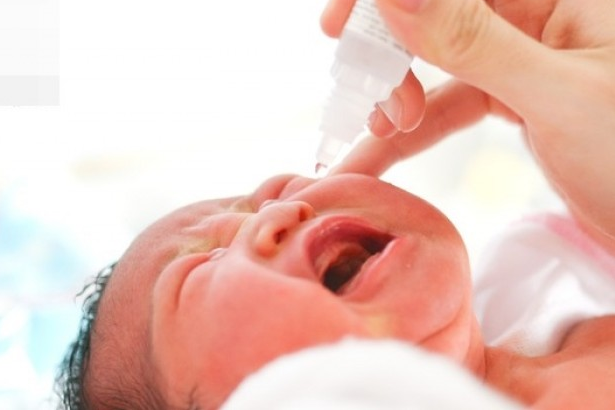Antibiotic eye drops for neonatal conjunctivitis
Neonatal conjunctivitis is a red eye caused by an infection, irritation, or blockage of the tear ducts. If you don't use antibiotic eye drops for children with conjunctivitis and let the infection develop, it can be very dangerous.
1. What are the symptoms and causes of neonatal conjunctivitis?
Symptoms of infant conjunctivitis generally include red eye(s) and swollen, red, and tender eyelids, with some pus.
The cause of conjunctivitis in newborns is often difficult to determine, it can be due to blocked tear ducts, irritation, or a viral or bacterial infection that the mother passes on to her baby during birth. For example, the virus that causes genital and oral herpes in a mother's vagina can cause neonatal conjunctivitis and serious eye damage.
The most common bacteria that cause conjunctivitis in children are Chlamydia, gonorrhea, Neisseria, and other viruses and bacteria that can also cause conjunctivitis in babies, but less commonly.
1.1 Neonatal conjunctivitis due to Chlamydia trachomatis About half of all neonatal conjunctivitis cases are caused by Chlamydia. Women with untreated Chlamydia trachomatis can pass the bacteria to their babies during delivery and cause neonatal conjunctivitis. Symptoms, including red eyes, swollen eyelids, and discharge, usually appear 5 to 12 days after birth. Chlamydia trachomatis bacteria can infect the lungs and nasopharynx (where the posterior nose connects to the mouth) and lead to pneumonia.
MORE: Risk of conjunctivitis in neonates of mothers infected with gonorrhea
1.2 Neonatal conjunctivitis due to gonococcal Neisseria gonorrhoeae causes neonatal gonococcal conjunctivitis. Women with untreated gonorrhea can pass the bacteria on to their babies during childbirth. Symptoms of neonatal gonococcal conjunctivitis usually include red eyes, thick pus in the eyes, swelling of the eyelids, and the illness begins about 2 to 4 days after the baby is born. There is an association between neonatal conjunctivitis caused by gonococcal infection and the risk of bacteremia (severe blood infection) and the risk of meningitis and spinal cord inflammation in these children.

Viêm kết mạc ở trẻ sơ sinh cần được phát hiện và điều trị sớm
1.3 Chemical infant conjunctivitis To help prevent bacterial infection, antibiotic eye drops for infants are often used. However, the child's eyes can become irritated and this can be diagnosed as chemical conjunctivitis. Symptoms of chemical infant conjunctivitis typically include mild red eye(s) and eyelid swelling and, rarely, discharge. Symptoms can last only 24 to 36 hours after birth.
2. How is conjunctivitis in infants treated?
Antibiotic eye drops for children are commonly used to treat neonatal conjunctivitis caused by a bacterial infection. Depending on the severity and bacteria causing conjunctivitis in infants, the doctor will choose an antibiotic with the appropriate dosage form in the form of eye drops or ointment in the eye or oral or intravenous medication. circuit or combination.
With conjunctivitis in infants caused by Chlamydia, the child will be given antibiotics capable of killing Chlamydia. If gonorrhea is the cause of conjunctivitis in a newborn, antibiotics will be given intravenously. Chemical conjunctivitis usually doesn't require treatment, and babies usually get better in 24 to 36 hours.
Particularly for bacterial and viral conjunctivitis other than Chlamydia trachomatis and Neisseria gonorrhoeae, antibiotic eye drops for neonates are preferred for local treatment. Doctors often prescribe antibiotic drops or ointments to treat conjunctivitis caused by other bacteria.
Besides treating the cause, improving the symptoms will help the child feel better. Parents can wash an infant's infected eye with a saline solution to remove any accumulated pus. If your child has a blocked tear duct, gently massage and warm the eye and nose area with a warm compress to reduce swelling. In cases where the lacrimal gland is blocked until the child is 1 year old, surgery to open the tear duct may need to be considered. You should make sure to wash your hands before and after touching your child's infected eye.
MORE: Diagnosis and treatment of conjunctivitis due to occlusion of the lacrimal gland in infants

Sử dụng thuốc kháng sinh nhỏ mắt cho trẻ cần thực hiện theo đúng chỉ định của bác sĩ
3. Can neonatal conjunctivitis be prevented?
If not treated in time, babies can develop corneal ulcers and lead to blindness. Therefore, neonatal antibiotic eye drops are recommended to prevent neonatal conjunctivitis. During pregnancy and before delivery, women with genital herpes should consult their doctor about ways to minimize the chance of spreading it to their baby to avoid serious risks from conjunctivitis. neonatal herpes due to herpes.
To prevent unwanted complications, especially to limit the risk of extremely dangerous antibiotic resistance, parents should take their children to medical centers for examination and prescribed use. suitable antibiotic for the treatment of conjunctivitis in children.
With many years of experience in examining and treating diseases in children, now the Pediatrics Department at Vinmec International General Hospital has become one of the major health care centers, capable of examining screening and treatment of many specialized diseases in children. Therefore, if the child shows signs of conjunctivitis, parents can take the child to Vinmec International General Hospital for examination and receive support and advice from doctors and pharmacists. Use effective antibiotics to avoid dangerous antibiotic resistance.
Để đặt lịch khám tại viện, Quý khách vui lòng bấm số HOTLINE hoặc đặt lịch trực tiếp TẠI ĐÂY. Tải và đặt lịch khám tự động trên ứng dụng MyVinmec để quản lý, theo dõi lịch và đặt hẹn mọi lúc mọi nơi ngay trên ứng dụng.
References: ncbi.nlm.nih.gov, cdc.gov
Bài viết này được viết cho người đọc tại Sài Gòn, Hà Nội, Hồ Chí Minh, Phú Quốc, Nha Trang, Hạ Long, Hải Phòng, Đà Nẵng.






